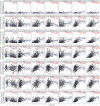Increased cytokine gene expression and cognition risk associated with androgen deprivation therapy
- PMID: 35821621
- PMCID: PMC9544768
- DOI: 10.1002/pros.24411
Increased cytokine gene expression and cognition risk associated with androgen deprivation therapy
Abstract
Background: Androgen deprivation therapy (ADT) is a standard treatment modality for locally advanced, high-risk, and metastatic hormone-sensitive prostate cancer. Long-term ADT treatment likely develops side-effects that include changes in cognition or onset of dementia. However, the molecular understanding of this effect remains elusive. We attempt to establish a link between ADT and changes in cognitive function using patient databases and bioinformatics analyses.
Methods: Gene expression profiling was performed using RNA sequencing data from Alzheimer patient cohort and compared with the data from advanced-stage prostate cancer patients receiving neoadjuvant antiandrogen therapy. Differentially expressed genes (DEGs) were analyzed using the Ingenuity knowledge database.
Results: A total of 1952 DEGs in the Alzheimer patient cohort and 101 DEGs were identified in ADT treated prostate cancer patients. Comparing both data sets provided a subset of 33 commonly expressed genes involving cytokine-cytokine signaling with an over representation of cytokine-cytokine receptor interaction, inflammatory cytokines, signaling by interleukins together with alterations in the circulating lymphocyte repertoire, adaptive immune responses, regulation of cytokine production, and changes in T-cell subsets. Additionally, lipopolysaccharide, tumor necrosis factor, and toll-like receptors were identified as upstream transcriptional regulators of these pathways. The most commonly expressed genes viz. IL-17A, CCL2, IL-10, IL-6, IL-1RN, LIF/LIFR were further validated by quantitative RT-PCR exhibited higher expression in antiandrogen treated neuronal, glial, and androgen-responsive prostate cancer cells, compared to no-androgen antagonist treatment.
Conclusions: Our findings suggest that changes in cytokine signaling under the influence of ADT in prostate cancer patients may be linked with cognitive impairment presenting new avenues for diagnostic and therapeutic development in combating brain deficits.
Keywords: androgen deprivation therapy; antiandrogens; brain deficits; cognitive impairment; proinflammatory cytokines; prostate cancer.
© 2022 The Authors. The Prostate published by Wiley Periodicals LLC.
Figures






References
-
- Gravis G, Boher JM, Joly F, et al. GETUG . Androgen deprivation therapy (ADT) plus docetaxel versus ADT alone in metastatic non castrate prostate cancer: impact of metastatic burden and long‐term survival analysis of the randomized phase 3 GETUG‐AFU15 trial. Eur Urol. 2016;70(2):256‐62. - PubMed
-
- Joly F, Alibhai SM, Galica J, et al. Impact of androgen deprivation therapy on physical and cognitive function, as well as quality of life of patients with nonmetastatic prostate cancer. J Urol. 2006;176(6 pt 1):2443‐2447. - PubMed
Publication types
MeSH terms
Substances
LinkOut - more resources
Full Text Sources
Medical
Miscellaneous

